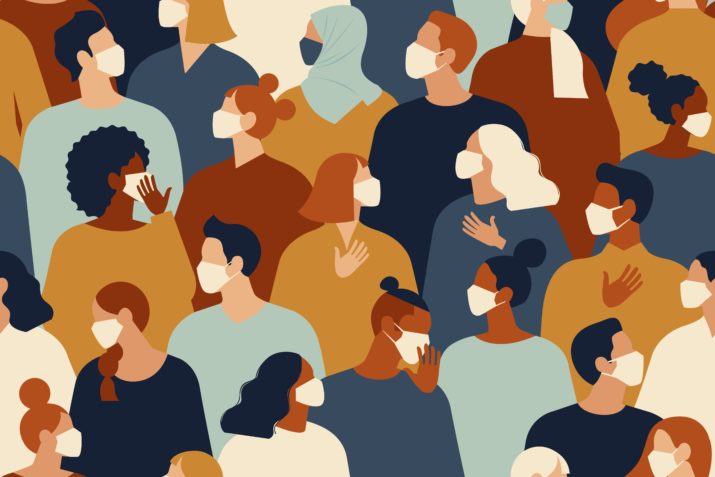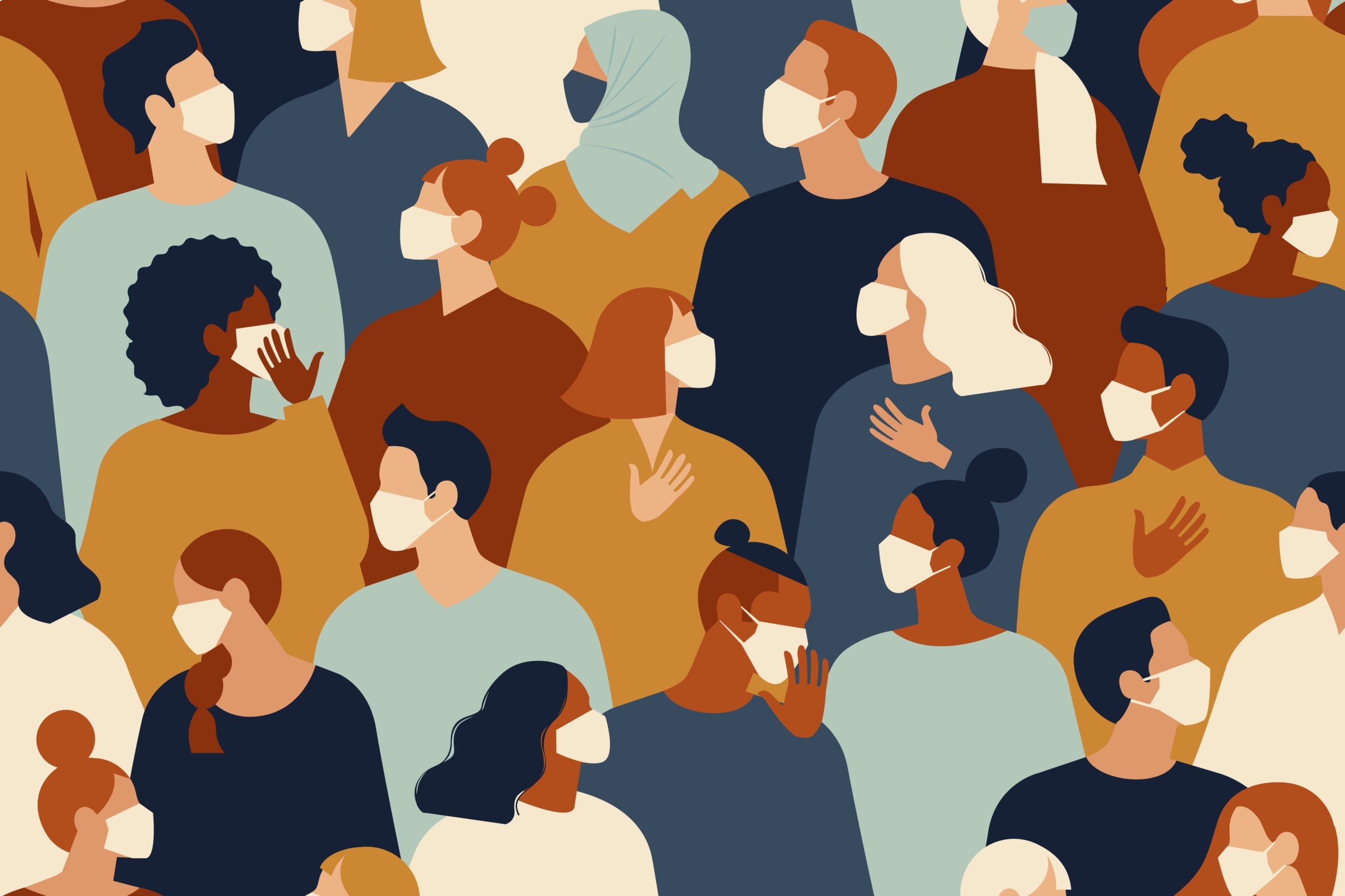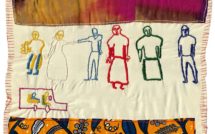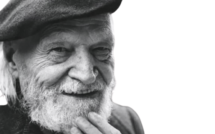

An introduction to our special feature, Networks of Solidarity in Times of Crisis.
From the onset of the global COVID-19 pandemic, local, state and federal governments, places of worship, universities, and even fashion companies have had us believe that “we are all in this together.”[1] But it quickly became apparent that the impact and cost of the pandemic was to play out very differently between the Global North and the Global South.
Nowhere is this more evident than the United States, where the pandemic exposed systemic inequities in the social and economic foundation of society. Death rates for Black Americans are more than three times higher than for white Americans, and outbreaks raged in places like the Navajo Nation, which has been systematically deprived of resources and health care.[2] School closures have been a blow for the exceptionally high (among wealthy nations) percentage of children living in poverty in the US, who rely on schools for meals and often lack reliable internet access.[3]
In Europe, the social compact of long-established welfare states and a robust health care system protected politically and economically marginalized groups to a much larger degree, but, as in the US, the pandemic has revealed the limits of states’ inclusion. Shutdowns negatively impacted economically precarious groups who might depend on a hot meal at senior citizen or youth centers that were forced to close once the pandemic struck. Unsurprisingly, recently arrived migrants and asylum seekers experienced the pain of the shutdowns acutely. Across the continent, migrant communities suffered higher infection and death rates, due largely to living in higher-density spaces, such as Paris’s banlieues or refugee homes in Germany.[4] In the early days of the pandemic, undocumented migrants were also particularly vulnerable to the heightened surveillance and control exercised over public areas in the name of preventing the spread of COVID-19.[5] Migrants have also been excluded or not fully included in recovery efforts. In Italy, migrants were not granted monetary subsidies given to the rest of the population to ease the impact of the lockdown.[6] Even Portugal’s relatively generous provisions—three months of regularized status for migrants with in-process cases[7]—cannot hope to redress long years of structural inequality that have left people from former colonies to contend with systemic exclusion and violence in the erstwhile European metropoles.
Nowhere was this lack of solidarity with societies’ most vulnerable people exposed so vividly as when Greece’s Moria refugee camp burned in September 2020. Twelve thousand refugees were left sleeping rough while European states haggled over if and how to intervene.[8] Similarly, in the face of the unprecedented COVID-19 pandemic, instead of forging a global solidarity to defeat the common threat, wealthy countries compete to produce vaccines, and buy up medical supplies, leaving poorer countries underprepared and wondering if they will be able to provide vaccine doses for their citizens.[9]
The pandemic has made the deep fissures in Western societies nearly impossible to ignore, even for those who had closed their eyes to them. The recognition of deeply entrenched racism, police violence, and poverty has pushed more people than ever into the streets in solidarity with one another. We can look to these popular movements to understand what it can look like to actually be “all in this together,” and to model the kinds of relationships we must create to forge true bonds of solidarity. Support for Black Lives Matter, for example, has increased dramatically since winter 2019, and the US has seen months of street protests in response to police violence against people of color and systemic racism more broadly.[10] After the May killing of George Floyd by Minneapolis police officers, demonstrations in solidarity with Black Americans and others sprang up in Europe and around the globe, challenging Europeans to reckon with police violence against people of color at home as well as abroad.[11]
This summer in Paris, protesters linked Adama Traoré’s death in police custody in 2016 to the police killings of Floyd, Michael Brown, Freddie Gray, and others in the US, explicitly making the conceptual links between systemic racism “here” and systemic racism “there” that are necessary for a solidarity that goes beyond empty words.[12] The images of dense crowds in Berlin, London, Bristol, Brussels, Copenhagen, Milan, Dublin, and elsewhere evoked European identifications with the American Civil Rights movement and broad solidarity with “Third World” liberation movements in the late 1960s and early 1970s. The Black Panther Solidarity Committees and Free Angela campaigns and the student protests against the Shah of Iran across the globe are prime examples of such transnational solidarity.[13]
These webs of solidarity and shared struggle (and performative allyship) are complicated indeed. They are somewhat reminiscent of the 1960s and 1970s, though only time will tell to what extent they will lead to structural policy changes. But when the splash of a slave trader’s statue being dumped into a harbor in Britain and the thud of statues of colonizers and conquistadors being torn down by Indigenous activists in Latin America add to the growing clamor to take down all Confederate monuments in the US, one cannot help feeling somewhat hopeful.[14]
Sometimes, being “all in this together” takes place within the context of transnational grassroots political movements, but sometimes acts of solidarity are more reflective of a recognition of shared human bonds. In 2015, Europeans—facing indifference, unpreparedness, or worse from their national leaders—stepped up and volunteered to assist hundreds of thousands of refugees making their way across Europe. Even now, when governments like Italy’s close their ports to boats crossing the Mediterranean, volunteers strike out into the sea to rescue migrants in danger. This same spirit animated Irish citizens to purchase food and supplies for Hopi and Navajo families in the US during COVID-19, in recognition of the Choctaw Nation’s financial support during the nineteenth-century Irish Potato Famine.[15]
The essays in this special feature on networks of solidarity in times of crisis offer us different expressions of solidarity from the past and present that prompt us to consider the political and interpersonal valences of such commitments. They follow groups of people confronting a wide range of challenges, from trauma to fascism, and the struggle to find dignified and fairly compensated employment as migrant workers. The essays also implicitly challenge the often dehistoricizing framing of a “crisis” by exploring the historical factors that set the stage for the present moment, such as systemic racism, gender-based violence, exploitation of workers, and more. Similarly, by taking an historical view, we can see how networks of solidarity built to withstand one type of challenge can adapt to political sea changes and continue to provide support and protection under new circumstances.
In the research section, Marcela Romero Rivera anchors her discussion of solidarity in the “revolutionary reproductive work” that Mexico performed for Republican Spain in the 1930s. For example, Mexico took in thousands of asylum seekers after Francisco Franco’s triumph in the Spanish Civil War, an important action that is often overshadowed by the Soviet Union’s high-profile support for the Republicans during the war. Romero Rivera argues that Mexican officials understood that their country’s public demonstrations of solidarity with Spaniards—looking after the physical, emotional, and political health of Republicans, including a keen attention to refugees’ traumas—was an ongoing process that also helped reproduce the Mexican Revolution’s own principles and commitments to internationalism.
Though we are not always schooled to read support provided by a former colony to its former colonizer as an act of solidarity, Romero Rivera’s essay shows us that this can be the case, underscoring the importance of incorporating nuanced historical perspectives from countries in the Global South into narratives of European history. The essay by Adedoyin Teriba on architecture as a self-fashioning enterprise in nineteenth-century colonial Nigeria is another such example. His essay provides startling insights on how formerly enslaved people trained in architecture traveled (returned, in some cases) from the Americas to Africa, and transformed the cosmopolitan cities of British-ruled Nigeria according to the Portuguese-inspired styles they employed as enslaved craftsmen in Brazil. Afro-Brazilians and other groups were variously united or at loggerheads, and sought to set in stone the results of their struggle for a post-slavery identity and sense of belonging.
Valeria Bonatti takes us to the twenty-first century, where many of the same questions about solidarity in extreme conditions persist. How do people pool their energies and resources to meet opportunities and risks, and halve the burden by doubling its bearers? Her discussion of migrant eldercare workers (women from Eastern Europe or the Global South) in Italy charts the economic and political obstacles faced by care workers, the community strategies they employ to address these challenges, and how their networks are being further tested and stressed by the COVID-19 pandemic. Bonatti challenges us to think harder about how to build a truly unified response to the pandemic by tracing the longstanding exploitative relationships between migrant care workers and the society in which they live and work: true solidarity will require upending many of these deeply unequal structures that make reproductive labor invisible.
All three essays in the research section deal with aspects of trauma resulting from forced migration, and how displaced people can overcome that trauma—be this by state-sponsored acts of solidarity, informal circles of migrant care workers, or through artistic (architectural) creation. In the Commentary section, Rachel Cohen and Catherine Butterly continue the discussion with their essay on textile-based therapies for women recovering from sexual violence and trauma, mostly related to displacement from war. In post-conflict areas such as Bosnia, the Democratic Republic of the Congo, and elsewhere, the hands-on process of creating story cloths to process the traumatic past can be a powerful healing tool. As a recent exhibition of story cloths at the UN demonstrates, creating textiles can make visible to a larger community the suffering of war and displacement, while also offering injured women healing and control over their stories.
Just as it is incumbent upon us to listen (and look) respectfully to narratives of trauma, we must also rethink the parameters of knowledge transfer when it comes to building dwellings with and for displaced people, argues Ayham Dalal in this issue’s featured interview. Dalal is based in Berlin, at the Technische Universität’s Habitat Unit, which takes a conscientious, balanced approach to collaborations between universities in the Global North and Global South. Through the Collaborative Research Center “Re-Figurations of Space,” Dalal helps students from around the world develop working relationships with one another and with the communities they seek to help: refugees in Jordan’s Gaza (Jerash) camp, for instance. Dalal addresses the uneven map of “overly connected” and “overly isolated” areas in the world, and offers suggestions for how to structure balanced encounters across borders and difference.
In the Campus Spotlight section, Bennington College faculty and students use a multidisciplinary lens to explore forced migration, exclusion from bodies politic, and other issues—and how these challenges can be confronted. Pairing critical reflection and analysis with a keen eye to current events and possible interventions, syllabi, and essays explore a rich blend of musicology, literature, political analysis, and close readings of contemporary politics around the world.
In the Campus section, essays from Bard College and Vassar College contribute to the “Digital Classroom” of pedagogical resources on forced migration initiated by the Consortium on Forced Migration, Displacement, and Education. Bard faculty and students present the in-progress work of their Border Pedagogy Working Group, featuring reflections on experiential border studies learning, collected syllabi and resources for cross-disciplinary study of the US-Mexico Border, and analysis of YouTube videos of residents’ encounters with US border enforcement officials. Vassar students inspired by the #CharlestonSyllabus and mentored by faculty contribute their Selective Bibliography of Forced Migration: a multidisciplinary, multimedia collection of resources to encourage a more nuanced public understanding of displacement and its accompanying challenges.
Three selected book reviews reflect on different aspects of displacement, trauma, and coping mechanisms. Two of the reviewed books are incidental to the theme of solidarity and crisis, but represent significant contributions to their respective fields. Justin Patch reviews Julie Sneeringer’s A Social History of Early Rock ‘N’ Roll in Germany: Hamburg from Burlesque to the Beatles, 1956-1969 and Maria Mitchell reviews Michael O’Sullivan’s Disruptive Power: Catholic Women, Miracles, and Politics in Modern Germany, two incisive reviews that ask us to rethink the usual pieties about cultural and religious life in a mid-twentieth-century Germany rocked by the postwar migration of millions of people to, from, and through the divided land.
The third is more germane to the theme of this special issue. Sarah Willen reviews Cultural Anxieties: Managing Migrant Suffering in France by Stéphanie Larchanché, about Centre Minkowska, a mental health clinic in Paris. Larchanché and Willen ask us to consider how “cultural competency” frames on both sides of the Atlantic might help forge a kind of solidarity between clinician and patient, by analyzing the clinic’s carefully developed protocols for dismantling the structural barriers that too often prevent those who have migrated from obtaining top-notch mental health care.
All of the essays in this special feature examine the traumas brought about by global displacement (historical and contemporary), and by the related disaster of COVID-19 that has caused people around the world to reflect anew on the historical foundations of their societies. Amid the convergence of the pandemic, global displacement, and continuing systemic exclusions, we must rethink how we relate to one another within and across borders, and how we might imagine new and enduring bonds of global solidarity.
Research
-
“Fostering a Revolution: Reproductive Work and the Spanish Republican Exile in Mexico” by Marcela Romero Rivera
-
“The Burden of Freedom: Therapeutic Architecture as Self Fashioning in the British Protectorate of Lagos (1830s-1900)” by Adedoyin Teriba
-
“Landscapes of Care and Isolation in the 21st Century: A Focus on Migrant Women in Italy” by Valeria Bonatti
Commentary
Visual Art
Interviews
Book Reviews
Campus Spotlight: Bennington College
-
“Landmine Clearance, Displacement, and Interdisciplinarity” by Noah Coburn, Sitashma Parajuli, Elbunit Kqiku
-
“Democracy’s Others: Migrating in a time of COVID-19” by John Hultgren, Soumya Rachel Shailendra, Sitashma Parajuli, and Ioanna Katsara
-
“Discovering (M)othertongues: A Reflection on the Conception of a Student-Run Publication” by Valeria Sibrian and Sarah Lore
-
“Syllabus: Dying in Diaspora” by Emily Mitchell-Eaton
-
“Syllabus: Sounding Home: Music of Migration, Memory, and Exile” by Joseph M. Alpar and Kerry Ryer-Parke
Matthew Brill-Carlat is the Coordinator of Research and Pedagogy with the Consortium on Forced Migration, Displacement, and Education, based at Vassar College. His research has also appeared recently in the Michigan Journal of History.
Ava McElhone Yates is a senior history major at Vassar College. From Easthampton, MA, she serves as a co-coordinator for the Consortium on Forced Migration, Displacement, and Education.
Maria Höhn is Professor of History on the Marion Musser Lloyd ‘32 Chair, Vassar College, and Director and PI of the Consortium on Forced Migration, Displacement, and Education.
References:
“#GucciCommunity for COVID-19.” Gucci. Accessed October 8, 2020.
“French police clash with anti-racism activists in Paris.” BBC, June 13, 2020.
“In Numbers: COVID-19 Across the Navajo Nation.” Navajo Times, accessed October 7, 2020.
“‘We’re All in This Together’: Coronavirus Task Force Addresses Nation.” New York Times, Video, June 26, 2020.
Alberti, Mia, and Vasco Cotovio. “Portugal gives migrants and asylum-seekers full citizenship rights during coronavirus outbreak.” CNN, March 30, 2020.
Bradley, Jane. “In Scramble for Coronavirus Supplies, Rich Countries Push Poor Aside.” New York Times, April 9, 2020.
Butterly, Luke. “Locked Down and Cast Out: Europe’s Migrants Navigate the Pandemic.” The Nation, April 15, 2020.
Domina, Thurston. “Coronavirus School Closings Threaten America’s Poorest Children.” The Conversation, accessed October 7, 2020.
Hedgpeth, Dana. “The Irish are repaying a favor from 173 years ago in Native Americans’ fight against coronavirus.” Washington Post, May 13, 2020.
Höhn, Maria, and Martin Klimke. A Breath of Freedom: The Civil Rights Struggle, African American GIs, and Germany. Palgrave Macmillan: New York. 2010.
Hulbert, Victor. “Adra Europe Issues Statement on COVID-19 Pandemic: We Are In This Together.” Ted News Network, April 17, 2020.
Landler, Mark. “In an English City, an Early Benefactor Is Now ‘a Toxic Brand’.” New York Times, June 14, 2020.
Louarn, Anna-Diandra. “Death tolls show France’s immigrants hardest hit by COVID-19, study finds.” InfoMigrants, July 17, 2020.
Otis, John. “U.S. Statue Removals Inspire Indigenous People In Latin America To Topple Monuments.” NPR, September 30, 2020.
Parker, Kim, Juliana Menasce Horowitz, and Monica Anderson. “Amid Protests, Majorities Across Racial and Ethnic Groups Express Support for the Black Lives Matter Movement.” Pew Research Center, June 12, 2020.
Radosavljevic, Zoran ed. “Italy approves parental leave, grants for the self-employed.” Euractiv, March 17, 2020.
Safronova, Valeriya. “Black Germans Say It’s Time to Look Inward.” New York Times, October 5, 2020.
Stevis-Gridneff, Matina. “After Fire Razes Squalid Greek Camp, Homeless Migrants Fear What’s Next.” New York Times, September 13, 2020.
Wood, Graeme. “What’s Behind the COVID-19 Racial Disparity?,” The Atlantic. May 27, 2020.
[1] “‘We’re All in This Together’: Coronavirus Task Force Addresses Nation,” New York Times, video, June 26, 2020; Victor Hulbert, “Adra Europe Issues Statement on COVID-19 Pandemic: We Are In This Together,” Ted News Network, April 17, 2020; “#GucciCommunity for COVID-19,” Gucci, accessed October 8, 2020.
[2] Graeme Wood, “What’s Behind the COVID-19 Racial Disparity?,” The Atlantic, May 27, 2020; “In Numbers: COVID-19 Across the Navajo Nation,” Navajo Times, accessed October 7, 2020.
[3] Thurston Domina, “Coronavirus School Closings Threaten America’s Poorest Children,” The Conversation, accessed October 7, 2020.
[4] Anna-Diandra Louarn, “Death tolls show France’s immigrants hardest hit by COVID-19, study finds,” InfoMigrants, July 17, 2020.
[5] Luke Butterly, “Locked Down and Cast Out: Europe’s Migrants Navigate the Pandemic,” The Nation, April 15, 2020.
[6] Zoran Radosavljevic, ed., “Italy approves parental leave, grants for the self-employed,” Euractiv, March 17, 2020.
[7] Mia Alberti and Vasco Cotovio, “Portugal gives migrants and asylum-seekers full citizenship rights during coronavirus outbreak,” CNN, March 30, 2020.
[8] Matina Stevis-Gridneff, “After Fire Razes Squalid Greek Camp, Homeless Migrants Fear What’s Next,” New York Times, September 13, 2020.
[9] Jane Bradley, “In Scramble for Coronavirus Supplies, Rich Countries Push Poor Aside,” New York Times, April 9, 2020.
[10] Kim Parker, Juliana Menasce Horowitz, and Monica Anderson, “Amid Protests, Majorities Across Racial and Ethnic Groups Express Support for the Black Lives Matter Movement,” Pew Research Center, June 12, 2020.
[11] Valeriya Safronova, “Black Germans Say It’s Time to Look Inward,” New York Times, October 5, 2020.
[12] “French police clash with anti-racism activists in Paris,” BBC, June 13, 2020.
[13] Maria Höhn and Martin Klimke, A Breath of Freedom: The Civil Rights Struggle, African American GIs, and Germany (Palgrave Macmillan: New York), 2010.
[14] Mark Landler, “In an English City, an Early Benefactor Is Now ‘a Toxic Brand’,” New York Times, June 14, 2020; John Otis, “U.S. Statue Removals Inspire Indigenous People In Latin America To Topple Monuments,” NPR, September 30, 2020.
[15] Dana Hedgpeth, “The Irish are repaying a favor from 173 years ago in Native Americans’ fight against coronavirus,” Washington Post, May 13, 2020.
Photo: Coronavirus pandemic, people in white medical face mask | Shutterstock
Published on October 13, 2020.




